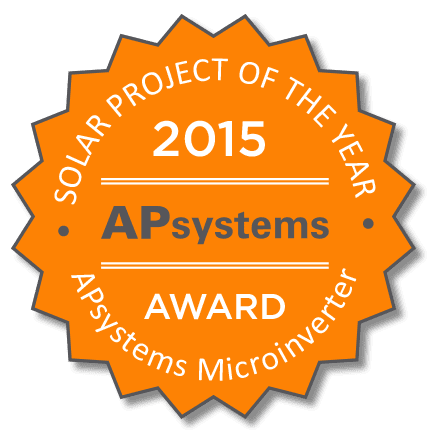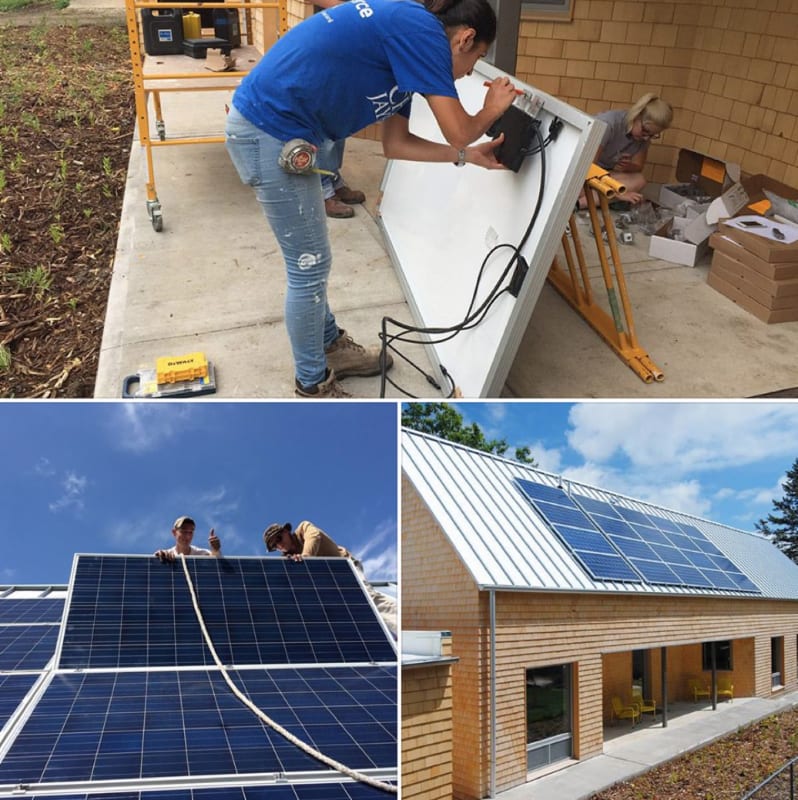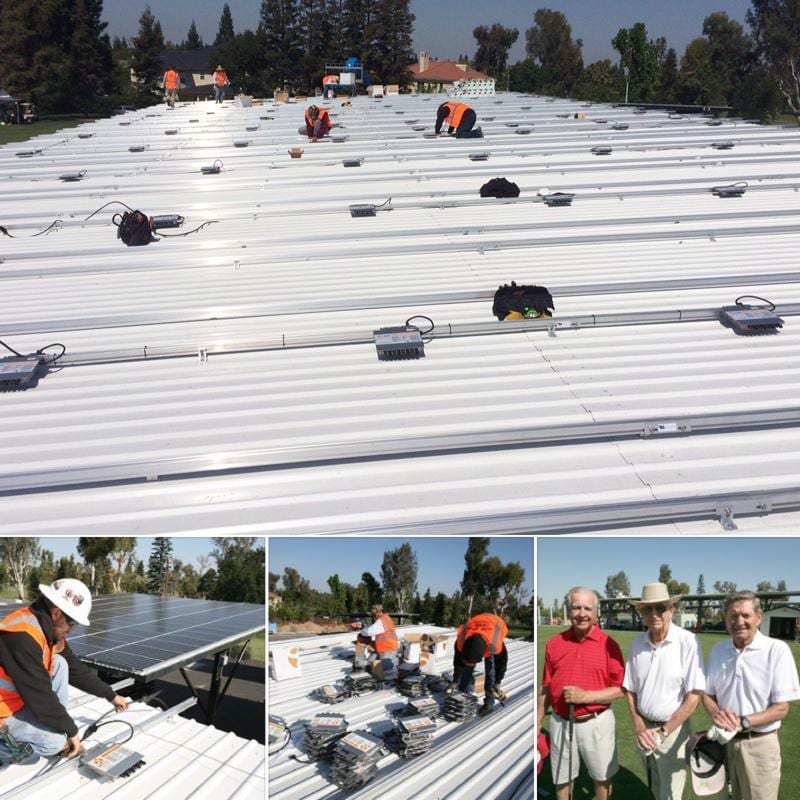Studio 804 at the University of Kansas, and Valley Unique Electric/Solar Universe of Fresno, Calif., have earned APsystems 2015 Project of the Year Awards.
The awards honor outstanding solar installations that showcase APsystems microinverter technology in their design and construction. Studio 804 is recognized in the residential project category, and Valley Unique Electric for a commercial installation.

“The Studio 804 and Valley Unique Electric projects exemplify the very best use of APsystems solar microinverter technology,” said Jason Higginson, Director of Marketing at APsystems. “From smaller, residential-scale arrays to expansive commercial installations, APsystems microinverters are the choice for innovative PV applications like these. We’re very proud to honor Studio 804 and Valley Unique Electric for these excellent projects.”
Studio 804, a nonprofit organization that supports the graduate program of the University of Kansas Department of Architecture, Design and Planning, is honored for its East Lawrence Passive House in Lawrence, Kan.
Designed and built by graduate students and sited in a historic residential district, the home uses renewable building materials and leading-edge systems to optimize energy efficiency.
Students included a 6kW rooftop solar array using APsystems YC500 dual-module microinverters to help the homeowners achieve energy independence.
“Holistic home design cannot be achieved without the consideration for solar applications,” said Dan Rockhill, University of Kansas architecture professor and Studio 804 advisor. “Taking proactive steps in monitoring and maintaining one’s energy consumption is prudent in today’s society. We were fortunate enough to partner with APsystems. The application, installation, and maintenance of their microinverters was straightforward. The ease at which our students were able to integrate the microinverters into the PV system was extremely successful, and the current homeowner could not be happier with the final product.”
Learn more about this project here.

Valley Unique Electric/Solar Universe is honored for its Fort Washington Country Club installation in Fresno, Calif.
The ambitious commercial project saw construction of towering carports with almost 36,000 square feet of roof space for solar to power the country club’s operations.
Across seven rooftops, 429 APsystems YC1000 true 3-phase microinverters serve more than 1,700 modules for a system capacity of 529kW.
“Solar carports are strong in Fresno, and we dominate the local market in putting them up,” said Hogi Selling IV, Valley Unique Electric president. “APsystems microinverters have been a key component of projects like the country club, and have proven themselves in the tough, hot conditions of the valley.”
Learn more about this project here.

The APsystems Project of the Year Awards are given annually to highlight innovative use of APsystems solar microinverter products. Previous honorees have showcased the company’s microinverter technology in an agricultural setting and atop a landmark heritage building in Washington D.C.
 Introducing TEDDY Talks powered by APsystemsJune 13, 2025 - 12:05 am
Introducing TEDDY Talks powered by APsystemsJune 13, 2025 - 12:05 am Share Your APsystems Story Enter to Win a 2-Night Stay in Vegas!June 2, 2025 - 9:53 pm
Share Your APsystems Story Enter to Win a 2-Night Stay in Vegas!June 2, 2025 - 9:53 pm The Future of Solar & Storage: How APsystems Is Using AI to Build a Smarter Energy EcosystemJune 12, 2025 - 1:56 am
The Future of Solar & Storage: How APsystems Is Using AI to Build a Smarter Energy EcosystemJune 12, 2025 - 1:56 am We don’t just talk tech — we teach it.June 12, 2025 - 1:31 am
We don’t just talk tech — we teach it.June 12, 2025 - 1:31 am Disrupting Commercial Solar: Why Installers Are Switching to the QT2June 2, 2025 - 9:43 pm
Disrupting Commercial Solar: Why Installers Are Switching to the QT2June 2, 2025 - 9:43 pm



ECU + EMA = a powerful duo for your microinverter array
/in Article, General News/by APsystems TeamModule-level monitoring is an essential feature of a microinverter solar array. APsystems offers advanced and user-friendly system monitoring for installers and end users alike.
The APsystems Energy Communication Unit is the gateway to our microinverters. An array can be easily configured BEFORE reaching the jobsite, so commissioning is a breeze. And the ECU requires no additional wiring; the simple plug-and-power design simplifies setup at the customer’s home or business.
The Energy Monitoring & Analysis software offers comprehensive, round-the-clock assurance of system performance. The homeowner’s EMA account provides module-level data, production and savings over time, while the installer account offers a more robust feature set for system configuration, mapping and control.
Join APsystems at Intersolar Summit East in Brooklyn, March 24
/in Events, General News/by APsystems TeamThe eastern U.S. solar markets of New York, New Jersey, Connecticut and Massachusetts are hot in 2016, and APsystems has the solutions installers need.
Our team will be at the Intersolar Summit East in Brooklyn, N.Y., on March 24, to present the APsystems microinverter line to new customers and longtime solar partners alike.
This important industry platform brings together manufacturers, distributors, installers and other leaders to keep on top of the latest policies, opportunities and issues impacting East Coast renewable production and storage markets.
Find out more at www.intersolar.us, and set up a meeting with the APsystems team by emailing sales@APsystems.com.
A Great Start to 2016
/in Events, General News/by APsystems TeamThank you from the APsystems team to all of our solar partners, for connecting with us at the Solar Power PV Conference and Expo in Boston this past month. What a great start to the year, for APsystems and the solar industry.
APsystems was proud to showcase the world’s most advanced microinverters at the PV Expo event, and to discuss our outstanding value and support with installers and distributors alike. We’re grateful for your interest and have much more to share – you’ll be hearing more from us throughout the coming weeks.
Another highlight: introducing solar industry veteran Andrew Nichols, our new Senior Vice President of Sales, USA. Thank you to all who came by the APsystems booth to congratulate Andrew and welcome him to our team.
With such a dynamic year ahead, we look forward to working with each of you to bring the power of solar to customers across the nation and worldwide. Striving together toward a clean energy horizon, our future is bright.
— The APsystems team
Nichols Joins APsystems as Senior VP, USA Sales
/in General News, Press Releases/by APsystems TeamFOR IMMEDIATE RELEASE
SEATTLE – Solar industry veteran Andrew Nichols has joined APsystems as Senior Vice President of Sales, USA.
Prior to this he served as Vice President of Sales and Customer Support for Enphase Energy, as it went from zero revenue to over $200 million in annual sales and an eventual IPO.
He also ran North American Renewable Energy Sales for Xantrex Technology (acquired by Schneider Electric). He began his career at IBM/ROLM and held positions of increasing responsibility at Apple before committing the last 11-plus years to the renewable energy industry.
He holds a BA in social sciences from the University of California, Berkeley.
“APsystems is the emergent front-runner in solar microinverter technology, and I’m honored to join their team,” Nichols said.
“Their commitment to innovation in module-level electronics is really showing the way forward in this fast-growing segment.”
Andrew Lonseth, APsystems president for U.S. operations, said Nichols’ broad experience in renewable energy brings both strategic and customer-facing value.
“Andrew Nichols knows the domestic and international solar market like few others,” Lonseth said. “Bringing his expertise into play as we grow our product portfolio and market share will serve both APsystems and our customers very well.”
Since its founding in Silicon Valley in 2009, APsystems has emerged as an industry leader through innovative solar products including dual-module microinverters and the first true 3-phase, four-module unit.
APsystems ranked no. 2 in global market share among microinverter suppliers by shipments in 2014 (source: GTM Research).
APsystems USA has offices in Cupertino, Calif., and Seattle, with manufacturing in Washington state.
See APsystems microinverters at Solar Power PV Conference & Expo
/in Events, General News/by APsystems TeamSee the APsystems YC500 dual-module and YC1000 true 3-phase microinverters, and learn how our advanced, chip-based product architecture means superior reliability and value for installers and end users alike.
APsystems will be at booth 515 on the convention floor in the Westin Boston Waterfront’s Galleria Hall.
Find out why APsystems ranked no. 2 in global market share among microinverter suppliers by shipments in 2014 (source: GTM Research).
Set up a meeting with the APsystems team: email sales@APsystems.com.
Studio 804, Valley Unique Electric earn APsystems Project of the Year Awards
/in Awards, General News/by APsystems TeamStudio 804 at the University of Kansas, and Valley Unique Electric/Solar Universe of Fresno, Calif., have earned APsystems 2015 Project of the Year Awards.
The awards honor outstanding solar installations that showcase APsystems microinverter technology in their design and construction. Studio 804 is recognized in the residential project category, and Valley Unique Electric for a commercial installation.
“The Studio 804 and Valley Unique Electric projects exemplify the very best use of APsystems solar microinverter technology,” said Jason Higginson, Director of Marketing at APsystems. “From smaller, residential-scale arrays to expansive commercial installations, APsystems microinverters are the choice for innovative PV applications like these. We’re very proud to honor Studio 804 and Valley Unique Electric for these excellent projects.”
Studio 804, a nonprofit organization that supports the graduate program of the University of Kansas Department of Architecture, Design and Planning, is honored for its East Lawrence Passive House in Lawrence, Kan.
Designed and built by graduate students and sited in a historic residential district, the home uses renewable building materials and leading-edge systems to optimize energy efficiency.
Students included a 6kW rooftop solar array using APsystems YC500 dual-module microinverters to help the homeowners achieve energy independence.
“Holistic home design cannot be achieved without the consideration for solar applications,” said Dan Rockhill, University of Kansas architecture professor and Studio 804 advisor. “Taking proactive steps in monitoring and maintaining one’s energy consumption is prudent in today’s society. We were fortunate enough to partner with APsystems. The application, installation, and maintenance of their microinverters was straightforward. The ease at which our students were able to integrate the microinverters into the PV system was extremely successful, and the current homeowner could not be happier with the final product.”
Learn more about this project here.
Valley Unique Electric/Solar Universe is honored for its Fort Washington Country Club installation in Fresno, Calif.
The ambitious commercial project saw construction of towering carports with almost 36,000 square feet of roof space for solar to power the country club’s operations.
Across seven rooftops, 429 APsystems YC1000 true 3-phase microinverters serve more than 1,700 modules for a system capacity of 529kW.
“Solar carports are strong in Fresno, and we dominate the local market in putting them up,” said Hogi Selling IV, Valley Unique Electric president. “APsystems microinverters have been a key component of projects like the country club, and have proven themselves in the tough, hot conditions of the valley.”
Learn more about this project here.
The APsystems Project of the Year Awards are given annually to highlight innovative use of APsystems solar microinverter products. Previous honorees have showcased the company’s microinverter technology in an agricultural setting and atop a landmark heritage building in Washington D.C.
Solar Builder highlights APsystems chip-based design
/in General News, Press Coverage/by APsystems TeamLevelized Cost of Energy — the total cost of a PV system’s installation and maintenance over its lifetime, divided by the amount of power produced – is the industry standard for measuring a PV system’s value.
Individual components like microinverters are key to the formula.
In its new story “LCOE Heroes: How inverters drive down PV levelized cost of energy,” Solar Builder magazine considers how the proprietary APsystems chip-based design means better long-term value for installers and end buyers.
That means savings at the supply and manufacturing level that cascade into real savings for customers.
“The FPGA architecture allows multiple, distinct processes to run in parallel on the same chip,” Jason Higginson, senior director of marketing at APsystems, tells the magazine. “This cuts down significantly on the number of internal components. This again is a significant savings at the supply-chain level as fewer components must be sourced to manufacture each unit, while also gaining an increase in reliability.”
Read more on APsystems chip-based microinverter design and its effect on levelized system costs at Solar Builder magazine online.
Olivier Jacques to lead APsystems Europe, Middle East and Africa operations
/in General News, Press Releases/by APsystems TeamOlivier Jacques has joined APsystems as Senior Vice President and Managing Director, Europe, Middle East and Africa. He is based in Lyon, France.
Jacques brings more than 20 years of experience in construction, industrial and high-tech industries. Prior to joining APsystems, he served as Managing Director EMEA for Enphase Energy. There, he developed the microinverter market in Europe from scratch, achieving leading share positions in key European solar regions.
APsystems ranked no. 2 in global market share among microinverter suppliers by shipments in 2014 (source: GTM Research, Smart and AC PV Modules 2015 – 2020).
“I am very excited to join APsystems in such a key development phase globally,” Jacques said. “The company is now increasing its presence in Europe, the Middle East and Africa, and I am absolutely convinced that AP systems’ portfolio strategy will bring outstanding value to solar professionals in these regions, especially given the current energy management market trends dynamic.”
Jacques previously served as managing director for several international concerns including Norgren (IMI group), a leading industrial automation and fluid control company, where he spurred growth despite an economic recession.
As France Managing Director and HVAC-R Southern Europe Director at Danfoss Drives, he increased revenues, created sales channels, launched a new product platform and repositioned the company as a value-added solutions provider.
He has also held senior executive positions at major companies ranging from WATTS Industries (fluid control and HVAC), Schlumberger (water, gas and thermal energy) and Samsung Electronics (launching of the HVAC business).
WEBINAR: Microinverters in commercial installations: sign up now for Jan. 26
/in Events, General News, Trainings, Webinar/by APsystems TeamJoin solar industry veteran Christopher Barrett of APsystems as he discusses why three-phase, multi-module microinverters are a great choice for your next commercial rooftop customer.
You will learn:
The webinar begins at 11 a.m. PDT Jan. 26.
Sign up for this informative webinar here. For more information, contact info@APsystems.com or see Solar Power World Online.
Take our survey, enter to win $500
/in Events, General News, Survey/by APsystems TeamAre you an installer, contractor or distributor? Do you use, specify, purchase, market or install solar inverter products? Take a few minutes to complete this survey, and you will be eligible to win a $500 Visa® gift card.
It’s this easy: By answering all questions in the short survey, you’ll help us better understand customer needs and improve our products and services. The survey is completely anonymous, and any personal information is only gathered for prize notification purposes.
The survey closes January 31– please share your opinions today.
To thank you for participating, we’ll enter you in a drawing for our prize – a Visa® gift card valued at $500.